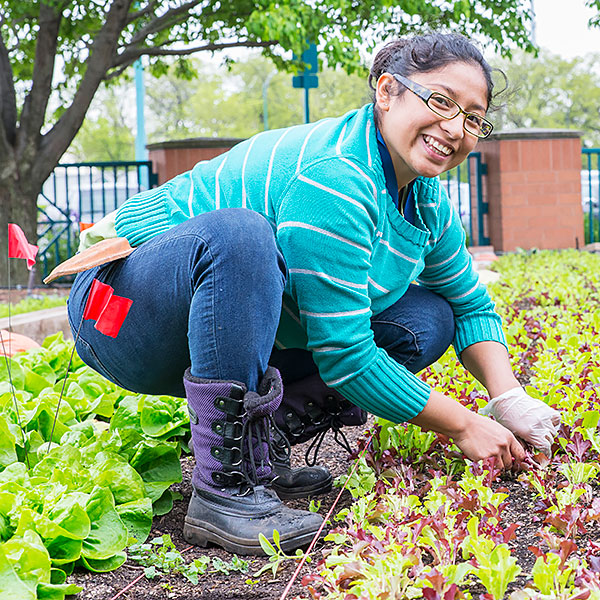

Tips & Techniques
Gardening as Therapy

Gardening has always been recognized as a form of therapy. At one extreme you have professional horticultural therapists working within the Chicago Botanic Garden's Buehler Enabling Garden; at the other, you have gardeners simply escaping the noises of the street or spending time in the company of growing things. Below, a Chicago Botanic Garden master gardener discusses gardening as therapy.
Chores Become Their Own Rewards
Taking an active part in the work of the garden can be therapeutic, as long as it is something you enjoy doing. What could be more exhilarating, for example, than raking leaves on a crisp autumn day? Even mowing the lawn can be therapy for some. I have a neighbor who mows his lawn at least twice a week simply because he loves to cut grass. For most people it would be a chore, but for him it's enjoyable and therapeutic.
One of the garden's more tedious jobs is weeding, but with a little imagination, I've turned it into a game I call "Good Guys Against Bad Guys." When I enlist my two grandsons, ages 3 and 6, in my war against weeds, it makes great sense to them. Amazing how quickly we can break through enemy lines when we're rescuing primroses from garlic mustard! To be honest, their interest soon flags, and I'm left to fight on alone. But, silly or not, my method works for me, and I get great satisfaction every time I yank one of those bad guys out of the ground.
Eyes on the Prize
Planting bulbs can be good therapy too where I use my imagination in a different way. The ground is always rock-hard in the fall, and if I couldn't visualize the end result of my digging, I don't think I could finish the job. But each time I dig a hole, I imagine masses of purple and yellow crocuses; yellow daffodils; red, orange, and yellow tulips; white snowdrops; and blue grape hyacinths—a springtime panorama of color that helps ease the pain of aching muscles. Great therapy for a gardener!
When winter comes, gardening moves indoors to sunny windowsills, where most gardeners are restricted to a few houseplants. How does a gardener get through the difficult months ahead? Here again, imagination helps. Most gardeners have no sooner put one garden to bed than they are planning the next one. And what better time to plan a garden than in the winter, when there is nothing to do but sit back in an easy chair and dream about next spring?
Armchair gardening is at its best with a garden catalog in one hand and a wish list in the other. The catalog should be generous with color photographs and enticing copy—copy that paints colorful pictures like "an exquisite warm orange beauty with exterior petals of empire rose." Or copy that tells exciting stories, such as "collected from the limestone crevices on the dangerous mile-high, windy ridges of Ula Dag, where no one has gone before." Or copy that whets the appetite like "cream petals suffused with a delicious raspberry shade that deepens toward the center." Copy, in short, that causes the wish list to grow until it appears endless, and the reader to become lost in a vision of spring, totally oblivious to the weather outside.
Head Outside Whatever the Weather
Garden catalogs do a great job of relieving the winter doldrums. But the best therapy for most gardeners is getting out in their yards, no matter what time of year. Even in winter, I know I will find something to catch my interest. The trees and shrubs are bare, but the ground covers are where the color is now. Bright green feverfew, purple ajuga, maroon epimedium, and big root geranium with pink and scarlet leaves. When temperatures hover just above freezing, the sweet woodruff and Siberian bugloss look almost indecently healthy. The hardy cyclamens and lungworts look beautiful with their gracefully mottled leaves. But then I find all of this beautiful and never tire of looking. For me, this is therapy.
What makes plants so effective in relieving stress? A horticultural therapist at the Chicago Botanic Garden's Enabling Garden sums it up well: "Plants provide us an escape. Whether through passive viewing or active gardening, our minds let go of current worries and become absorbed in positive thoughts of beauty, renewal, and wonder."

